Sterne Family
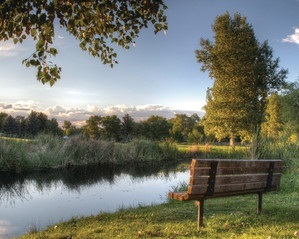
Sterne Park, 2012.
Who was the "Sterne" of Sterne Park and Sterne Parkway? Because William C. "Billy" Sterne had generously supported the little park since it was created in 1928 and because he had done so much for Littleton, the Littleton Civic and Commercial Association suggested the recreational spot be named in honor of him when they turned it over to the city in 1931. Bemis Street runs along its west side and Lake Avenue along its south side. Sterne Parkway starts at the south side of the park and runs diagonally to South Broadway.
Billy Sterne came to Littleton in 1895 because of his health. He had contracted tuberculosis, so common at that time. A small sanitarium had just been built adjacent to Lyndhurst and was under the supervision of Dr. McArthur. Lyndhurst was the name of Mayor Hampden H. Shepperd's large home on "Knob Hill" at the corner of Shepperd Avenue and Prince Street, (where the YMCA later stood). Shepperd was general agent for the Chicago and Alton Railway.
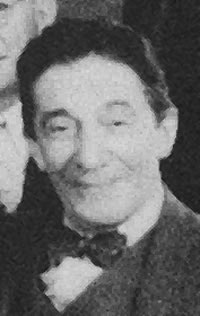
William C. "Billy" Sterne, date unknown.
William Charles Sterne was born December 13, 1869 at Peru, Indiana, one of seven children of Charles F. and Eugenia (Fries) Sterne. A biography of William C. Sterne was written in Colorado and Its People and published in 1948. According to it, his father founded the Peru Woolen Mills that specialized in making woolen blankets, at one time supplying the Pullman Company with the blankets used in their sleeping cars. When Billy was left an orphan at age eleven, he went to Cincinnati where his older sisters were attending boarding school, and he graduated from the White and Sykes School there in 1887. He then made his home with his married sister, Emma, and when he was ready for college she sent him off to Harvard where he graduated in 1891. Later he pursued graduate studies abroad. He desired to become a writer and lived for a time in Europe.
In Littleton the Hampden H. Shepperd household included their beautiful and accomplished daughter, Orian, who had been educated at the Pritchett Institute at Glasgow, Missouri. She had been one of Littleton's most popular belles since her return in 1894. William Sterne and Orian Shepperd were married April 28, 1898 in the Littleton Presbyterian Church downtown at Main and Curtice streets. She looked like a stately lily in white organdy and silk, with "natural orange blossoms in her hair," the gift of her brother in California, said the newspaper.
During this time Sterne, together with John C. Martin, had a drug store at what is now 2430 West Main Street. Although inexperienced as a pharmacist, there was no licensing system in those days, and Sterne filled prescriptions himself, pouring over a big pharmacopoeia to learn how to complete each one. Apparently he satisfied both doctors and patients by his painstaking if amateurish efforts. The drug store had the first telephone exchange in Littleton, and everyone in town relied on it when a call to Denver had to be made. In 1900 Billy Sterne and John Martin sold their drugstore to Charley L. Thompson.
The two partners also established the Sterne and Martin Extract Company in the building at the southwest corner of Nevada and Low streets where the Merry Canning and Pickle factory had been in the early 1890s. Here they used their "Vacuo-Process" to produce extracts for flavoring foods. Young Ed Bemis worked in the creamery in the same building and helped bottle the extracts for shipping. Flavors included vanilla, strawberry, cherry, grape and raspberry. In 1898 the Sterne and Martin Extract Company had a "very fine exhibit at the pure food show in Denver. The extracts...have gained a wide reputation," wrote the Littleton Independent. Sterne and Martin continued their extract business until 1907.
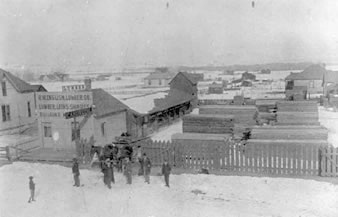
Littleton Lumber Co. on the north side of the 2400 block of Main Street, c.1890. The house on the far left is sitting on the property now covered by the Coors Building at the corner of Main Street and Nevada. Men in the photo include R.W. English and Harry Nutting.
Meanwhile, on August 1, 1902 Billy Sterne, his brother E. C. (Ed) Sterne and Harry Nutting bought the lumberyard at the northwest corner of Main and Prince from the R. W. English Lumber Company. The lumberyard office also housed the offices of the Bank of Littleton that had been organized in 1892. The Sterne brothers and Harry Nutting bought the bank along with the lumber company. Harry Nutting had been manager of the lumber company since 1889 and cashier of the bank since 1896. He continued in both capacities. The bank later became the First National Bank of Littleton. The lumber company was renamed the Littleton Lumber Company and continued doing business at Main and Prince until 1960 when it moved to 5250 South Santa Fe Drive.
In February 1902 Billy and Orian Sterne moved into the Shepperd mansion at Lyndhurst. Also in 1902 events transpired that were to have a profound effect upon Littleton. The state legislature agreed to divide the original Arapahoe County and create the City and County of Denver along with a new South Arapahoe County. Littleton was named the new temporary Arapahoe County seat and became the permanent county seat in 1904. In 1903 Nelson Rhoades obtained a franchise to build and operate an electric lighting system for the town. He and Billy Sterne established a coal-fired steam plant in the west side of the old canning factory at Nevada and Low streets, the same building where Sterne and Martin's Vacuo-Process was underway. (This building had a lot of uses! It also housed the Caley's cheese factory, and later it became the location of Holmes Motor Company followed by the American Coleman Company.) Sterne was fireman, meter reader and lamp trimmer, as well as president and secretary of the "Arapahoe Electric Light and Power Company." On Sunday, August 2, 1903 the whole town gathered to watch the lights be turned on. The company prospered and took in Englewood.
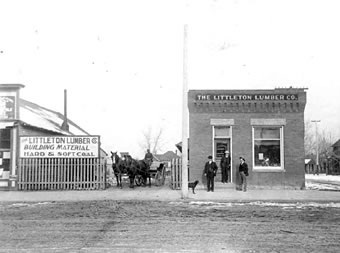
Littleton Lumber Co. office at the northwest corner of Main and Prince Streets. Built in 1901, this photo was taken four years later. Joe Wise is pictured sitting on the wagon, Manager Harry Nutting on left, Ed Sterne in doorway, Rupert E. "Skip" Nutting on right.
Billy Sterne soon built power generating plants at Fort Lupton, Johnstown, Milliken, Platteville and Keenesburg, Colorado, and at McCook, Nebraska and Laramie, Wyoming. Later his plants included those at Brighton, Golden and Arvada, Colorado. In 1926 he sold all his properties except Arvada.
Because of these extensive business interests, Billy Sterne moved his office and family to Denver about 1910 and lived at 1198 South Franklin Street in the Washington Park area.
Billy Sterne was notably public spirited. He served on the Denver Board of Education for twelve years, was president of the Board of Trustees of the Denver Art Museum and the Denver Civic Symphony Orchestra, a director of the Denver Chamber of Commerce and member of the Board of Trustees of the Child Research Council of Denver Hospital. Many of his light and power businesses were acquired by the Colorado Central Power Company that later became the Public Service Company of Colorado. Sterne was one of its directors at his death. He was the longtime president and manager of the Arvada Electric Company that he had retained. His clubs included the Rocky Mountain Harvard Club of which he was president at one time, Mile High, Wigwam, Cactus and Denver Press clubs.
Perhaps the remarkable fact was how, with these many commitments, he maintained his ties to Littleton. Billy Sterne was president of the Littleton Lumber Company for many years, was a twenty-five year Littleton Rotarian, a supporter of the Littleton Hose Company and a loyal member of the Weston Masonic Lodge. And he and his wife gave money and equipment to develop the little park, now Sterne Park, on what was then called Santa Fe Avenue.
William C. "Billy" Sterne died November 28, 1948 at his Denver home at age seventy-eight. The Littleton editor wrote, "One of his chief characteristics was his thoughtfulness. Whenever a friend was ill or had some other misfortune, Mr. Sterne paid a personal call or telephoned." A close friend at the Rocky Mountain News wrote, "Mr. Sterne was humble, wise and kind." Even after his death, along with a gift to the Littleton Fire Department, he aided Sterne Park with a large bequest for its improvement and beautification. "Littleton always held a very big spot in Dad's heart as it does in all of ours," said his son.
Mrs. Orian (Shepperd) Sterne, widow of William C. Sterne, was named the "Most Charming Woman of the Half Century" in Littleton in February 1951. Although she had lived in Denver for some years by then, she was remembered in Littleton as not only beautiful, but possessed of an inner graciousness and a deep and sensitive concern for other people. She was born September 2, 1875 in Missouri and died January 12, 1956 in Denver.
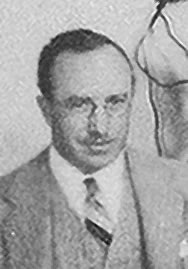
Charles Shepperd Sterne, date unknown.
Their son, Charles Shepperd Sterne, was born March 13, 1901 and spent his childhood at Lyndhurst. After graduating with honors from the Howe Military Academy in Howe, Indiana he studied electrical engineering at the University of Colorado from 1919 to 1923. The Littleton newspaper explained in Charles' obituary in 1977 that he did not graduate at that time because he missed a quarter of school when he took his eighteen-year-old sister to Hawaii for her health.
His sister was born October 12, 1904, and was named Orian for her mother. Young Orian died December 31, 1923 at age nineteen. The family erected a memorial fountain in her name on the grounds of the Carnegie Library at the west end of Main Street on October 12, 1924 on what would have been her twentieth birthday. The fountain was designed by architect Jacques Benedict so that it was in keeping with the architecture of the library which he had designed in 1916. It was made of Del Norte (Colorado) lava stone and was about fourteen feet across and ten feet high with a stone shaft in the center and benches on either side of a circular pool filled by a jet of water from the shaft. The benches bore inscriptions and were to be placed in such a way as to command the most attractive view of the Platte River and the mountains beyond. The pool was put in by a Mr. Sorenson, presumably a local craftsman, and the sculpturing done by Ernest Eddler of Kansas City. It was complete when dedicated except for the two black mosaic Tiffany panels at the top of the center shaft. They were reproductions of studies made by the young Orian. They were being made in Philadelphia and were installed later. The newspaper said that the fountain would be placed on the northwest side of the library grounds. After the dedication ceremony the newspaper reported that its location on the edge of the library grounds was not only appropriate, but carried the opportunity of making that the beauty spot of Littleton. The presentation speech was made by R. W. Candler and the acceptance speech by mayor W. C. Crysler.
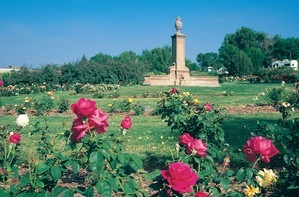
Orian Sterne Memorial Fountain at War Memorial Rose Garden near Sterne Park, 2003.
When the library building became the Littleton Police headquarters in the 1960s, the fountain was moved to the east end of Bowles Avenue and placed in the traffic "round-about" where Bowles, Rapp Street and Main converge near the Masonic Temple. In 1988 it was installed in the War Memorial Rose Garden at Bemis Street and West Shepperd Avenue where it stands very near the original site of the Lyndhurst home of the Shepperds and the Sternes. It faces east toward Sterne Park, named for Miss Sterne's father.
Billy and Orian's son, Charles, was named to the Denver Selective Service Board at the start of World War II. He then joined the Army himself and served in the signal corps. A ham radio operator, he later made friends around the world. He finally received his Bachelor of Science degree twenty-seven years after leaving the University of Colorado in 1923.
Charles largely followed in his father's footsteps. He was president of the Arapahoe Electric Light and Power Company and of the Littleton Lumber Company after his father's death. For nearly thirty-two years he was on the board of the Denver Symphony Association, much of the time as treasurer. He also was president of the Child Research Council and a trustee of United Way. He kept his ties to Littleton, as did his father, and was a leading member of Littleton Rotary for fifty-two years.
On September 22, 1927 he married Dorothy Elder at St. John's Episcopal Cathedral in Denver. She was the cousin of Horace Elder Tureman, early conductor of the Denver Symphony. This led to the couple's long interest in the Symphony Association. Charles S. Sterne died January 20, 1977. His only survivors were his wife and a cousin, Beverly A. Shepperd of Denver, the grandson of Hampden H. Shepperd. In October 1963 Charles S. Sterne and Loren Ringsted, then the owner and manager of the Littleton Lumber Company, were honored by the State Chamber of Commerce in recognition of the company's seventy-fifth anniversary.
Not only did Charles Sterne, as did his father, support Littleton's Sterne Park during his lifetime, in his will, along with bequests to the Littleton Rotary and Weston Masonic Lodge, he left a bequest for the park. A few months later an additional gift of $10,000 from his widow provided the picnic shelter at the northwest corner of the lake, along with landscaping and a new bridge over the lake's spillway.
The Lyndhurst mansion was eventually converted for use as the Littleton YMCA in the 1950s. It was razed in 1975, and a new building erected for that organization. Currently that building houses the Colorado Center for the Blind.
Bibliography
Colorado and Its People. New York, Lewis Publishing Company, 1948.
Littleton (Colo.) Independent. Littleton Independent Publishers, 1888-
Littleton Museum. Card file: Sterne, Shepperd; Photographic archives.
McQuarie, Robert J. and C. W. Buchholtz. Littleton, Colorado, Settlement to Centennial. Littleton, Colorado: Littleton Historical Museum and Friends of the Littleton Library and Museum, 1990.
The Oracle. Littleton, Colorado: Friends of the Littleton Library and Museum. March 2001.
Photographs courtesy of the Littleton Museum unless otherwise noted. To order copies, contact the museum at 303-795-3950.
Compiled by Doris Farmer Hulse
Updated September 2022 by Jenny Hankinson